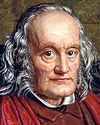
On 20 Jul 1804, Sir Richard Owen born, an English zoologist, anatomist and palaeontologist who could make remarkable reconstructions of many prehistoric animals and birds from even limited fossil evidence. Owen championed the idea of a new South Kensington building for the British Natural History Museum to house its burgeoning collections.
In his time, for his scientific work, he was so famous to the general public, that he was recognized in caricatures in popular magazines. For more of his accomplishments, read this article on Professor Owen from the magazine The Speakerpublished shortly after his death in 1892.
For a biography from a different author, giving some additional information, you can also read this chapter on Owen in the book, Biographies of Scientific Men, by A.B. Griffiths in 1912.

On 20 Jul 1804, Sir Richard Owen was born. By the mid-1850s, no scientist in the British Empire was more visible than Richard Owen.
Mentioned in the same breath as Isaac Newton and championed as Britain’s answer to France’s Georges Cuvier and Germany’s Alexander von Humboldt, Owen was, as the Times declared in 1856, the most “distinguished man of science in the country.”
But, a century and a half later, Owen remains largely obscured by the shadow of the most famous Victorian naturalist of all, Charles Darwin. Publicly marginalized by his contemporaries for his critique of natural selection, Owen suffered personal attacks that undermined his credibility long after his name faded from history.
Today's book pick is: , by , who resuscitates Owen’s reputation. Arguing that Owen should no longer be judged by the evolution dispute that figured in only a minor part of his work, Rupke stresses context, emphasizing the importance of places and practices in the production and reception of scientific knowledge. Dovetailing with the recent resurgence of interest in Owen’s life and work, Rupke’s book brings the forgotten naturalist back into the canon of the history of science and demonstrates how much biology existed with, and without, Darwin.
It is available from Amazon, typically about (As of earlier time of writing - subject to change.)
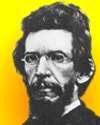 | Statistics are far from being the barren array of figures ingeniously and laboriously combined into columns and tables, which many persons are apt to suppose them. They constitute rather the ledger of a nation, in which, like the merchant in his books, the citizen can read, at one view, all of the results of a year or of a period of years, as compared with other periods, and deduce the profit or the loss which has been made, in morals, education, wealth or power. |
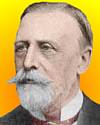 | Another source of fallacy is the vicious circle of illusions which consists on the one hand of believing what we see, and on the other in seeing what we believe. |
 | The invertebrated classes include the most numerous and diversified forms of the Animal Kingdom. At the very beginning of our inquiries into their vital powers and acts we are impressed with their important relations to the maintenance of life and organization on this planet, and their influence in purifying the sea and augmenting and enriching the land—relations of which the physiologist conversant only with the vertebrated animals must have remained ignorant. |
| Before you look at today's web page, see if you can answer some of these questions about the events that happened on this day. Some of the names are very familiar. Others will likely stump you. Tickle your curiosity with these questions, then check your answers on today's web page. | |
| Births | |
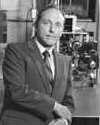 | Robert D. Maurer, born 20 Jul 1924, is an American research physicist, who with his colleagues, Dr. Donald B. Keck and Dr. Peter Schultz invented the fused silica optical waveguide. What is this used for, and what problem had they solved? |
 | Sir Richard Owen, born 20 Jul 1804, was an English anatomist and paleontologist who is remembered for his strong opposition to the views of Charles Darwin. He gave us many of the terms still used today in anatomy and evolutionary biology, including “homology.” He also created a word meaning “terrible lizard” (1842) that is well-known today. What is the word he coined for “terrible lizard”? |
| Deaths | |
 | An Italian inventor (1874-1937) invented the wireless telegraph in 1935 known today as radio. In 1894, he began experimenting on the “Hertzian Waves” (the radio waves Hertz first produced in his laboratory a few years earlier). Lacking support from the Italian Ministry of Posts and Telegraphs, he turned to the British Post Office. Encouraging demonstrations in London and on Salisbury Plain followed. In 1897, he obtained the world’s first patent for a system of wireless telegraphy. He opened the world’s first radio factory at Chelmsford, England in 1898. In 1900 he took out his famous patent No. 7777 for “tuned or syntonic telegraphy.” Can you name this inventor? |
| Events | |
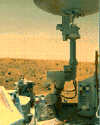 | On 20 Jul 1976, an American spacecraft, launched 20 Aug 1975, made its successful, first-ever landing on Mars at Chryse Planitia, and began transmitting pictures. Later, a robot arm that could scoop up samples of material and deposit them into on-board experiments, investigated the hint of life on Mars. Both weathered top soil and deeper soil samples were tested. What was the name of this spacecraft? |
 | On 20 Jul of a certain year, Apollo XI astronauts Neil Armstrong and Edwin “Buzz” Aldrin became the first men to walk on the moon, after their lunar module separated from the command module and landed on the lunar surface. Armstrong stepped on the lunar surface at 10:56 ET and proclaimed, “That's one small step for man, one giant leap for mankind.” Nearly 700 million people around the world were tuned in. What year did this event take place, and what is the name of the area where they landed? |
Fast answers for the previous newsletter for July 19: technique of radioimmunoassay (RIA) of peptide hormones • 1.65 miles (according to NOAA National Ocean Service) • nitrogen • Paris • Isambard Kingdom Brunel.
 If you enjoy this newsletter, the website, or wish to offer encouragement or ideas, please send feedback by using your mail reader Reply button.
If you enjoy this newsletter, the website, or wish to offer encouragement or ideas, please send feedback by using your mail reader Reply button. Your click on a Facebook, StumbleUpon, or other social button on the site webpages is also a welcome sign of appreciation. Thank you for using them.
© This newsletter is copyright 2020 by todayinsci.com. Please respect the Webmaster's wishes and do not put copies online of the Newsletter — or any Today in Science History webpage. (If you already have done so, please remove them. Thank you.) Offline use in education is encouraged such as a printout on a bulletin board, or projected for classroom viewing. Online, descriptive links to our pages are welcomed, as these will provide a reader with the most recent revisions, additions and/or corrections of a webpage. For any other copyright questions, please contact the Webmaster by using your mail reader Reply button.
--
If you do not want to receive any more newsletters, Unsubscribe
To update your preferences and to unsubscribe visit this link
Executive Real Estate Business Class
-
"It was like a man with wings. It wasn't like anything you'd see on TV or in a monster movie." ...
About the publisher
Search This Blog
Blog Archive
-
▼
2021
(585)
-
▼
July
(50)
- Newsletter for Saturday 31 July.
- Newsletter for Friday 30 July.
- Power off and play this summer!
- Newsletter for Thursday 29 July.
- Newsletter for Wednesday 28 July.
- Newsletter for Tuesday 27 July.
- Newsletter for Monday 26 July.
- Newsletter for Sunday 25 July.
- Newsletter for Saturday 24 July.
- Newsletter for Friday 23 July.
- Newsletter for Thursday 22 July.
- Newsletter for Wednesday 21 July.
- Newsletter for Tuesday 20 July.
- Newsletter for Monday 19 July.
- The Machines That Built America Premieres Tonight
- Newsletter for Sunday 18 July.
- Newsletter for Saturday 17 July.
- Newsletter for Friday 16 July.
- Newsletter for Thursday 15 July.
- Newsletter for Wednesday 14 July.
- Newsletter for Tuesday 13 July.
- On This Day for July 12 - Geraldine Ferraro design...
- Newsletter for Monday 12 July.
- Inventing ‘The Machines That Built America’
- On This Day for July 11 - Duel between Aaron Burr ...
- Newsletter for Sunday 11 July.
- On This Day for July 10 - Telstar 1 launched, John...
- Newsletter for Saturday 10 July.
- On This Day for July 9 - Catherine the Great assum...
- Newsletter for Friday 9 July.
- New Season! Hope, Through History Podcast
- On This Day for July 8 - Vasco da Gama's first voy...
- Newsletter for Thursday 8 July.
- Ending soon: savings that pop! 🎆
- On This Day for July 7 - Hawaiian Islands annexed ...
- Newsletter for Wednesday 7 July.
- On This Day for July 6 - Anne Frank forced into hi...
- Newsletter for Tuesday 6 July.
- On This Day for July 5 - Israel's Law of Return pa...
- Newsletter for Monday 5 July.
- On This Day for July 4 - Declaration of Independen...
- Newsletter for Sunday 4 July.
- July 4th Sale at the HISTORY Store!
- On This Day for July 3 - Battle of Gettysburg ende...
- Newsletter for Saturday 3 July.
- On This Day for July 2 - Civil Rights Act signed, ...
- Newsletter for Friday 2 July.
- July 4th savings that pop!
- On This Day for July 1 - Dominion of Canada establ...
- Newsletter for Thursday 1 July.
-
▼
July
(50)
-
Blogroll
-
About
HistoryFact










0 comments:
Post a Comment